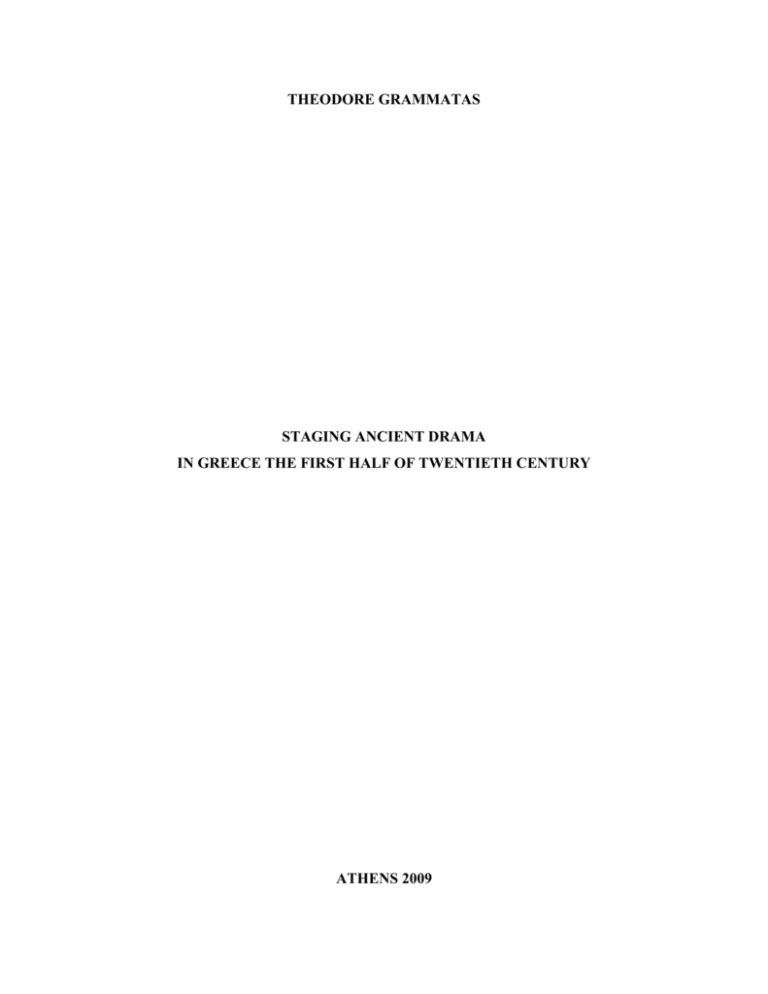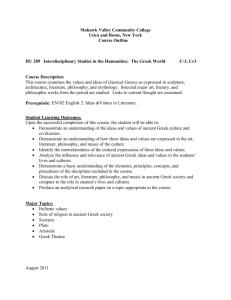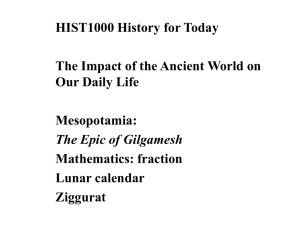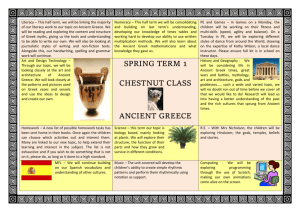THEODORE GRAMMATAS
advertisement

THEODORE GRAMMATAS STAGING ANCIENT DRAMA IN GREECE THE FIRST HALF OF TWENTIETH CENTURY ATHENS 2009 Milestone for the nineteenth century productions is the stage interpretation of Oedipus Rex by Jean Mounet Sully αnd the Comédie Française at the Athens Public Theater on September 28, 1899. For the first time then, it becomes quite clear that ancient Greek drama is not just philology that must be approached and interpreted correctly on the basis of a set of grammatical and syntactical rules, as it used to be up to that period, but a complex artistic creation engaged through an absolutely aesthetic communication between the audience and the totality of the stage spectacle. Furthermore, two leading stage directors of that period mark Greek theater’s course with their efforts and brilliant work: they are Konstantinos Christomanos and Thomas Oikonomou. Once more, and on the same level, modern Greece’s contact with its ancestral heritage is not a direct transfer of the tragedy’s production character from the ancient amphitheaters to the contemporary nineteenth century buildings; it is accomplished through a specific and established for this matter interpretation that combines philological, philosophical, aesthetic, and theatrical components that become mature and are expressed on a European level (Patsalidis 1997), as these two aforementioned directors had already formed their theatrical profile in Vienna and Munich. Konstantinos Christomanos, the founder of the New Scene, chooses Euripides’ Alcestis as the inaugural work for the opening of his Theater, staging it at the Variete Theater and presenting it to the Athenian audience on November 22, 1901 (Sideris 1976: 180-183). True to the general principles of both aestheticism and naturalism that he himself expressed, Christomanos gives priority to the tragedy’s spectacle. Thus, he emphasizes the aesthetic aspect of the production, paying attention to the stage scenery and the costumes, the décor and audio-visual effects, following the European models of aestheticism. Two years later (1903), continuing the efforts to renew ancient tragedy, Aeschylus’ Oresteia is produced by Thomas Oikonomou and the Royal Theater. The play opens on November 1st, 1903. Thomas Oikonomou’s direction is extremely well done, and according to the principles of German theater, that the director himself knew so well from the same drama’s production in Berlin in 1901. The actors played impressively, the stage décor was extremely detailed, the costumes came to Greece from abroad, being similar to those used at Vienna’s Burgtheater wardrobe. 2 The New Scene and Royal Theater performances mark the first representative efforts to renew the stage interpretation of ancient texts. In them, the directors puts more emphasis on the play’s content and gives priority to the philological reading of the work rather than to its stage interpretation. As such, the dramatic text is viewed as a totally independent and autonomous linguistic product of art. Along these lines, the ancient Greek language becomes diachronic and universal, revealed not through the process of reading but through its stage simulation. In this manner, with Konstantinos Christomanos’ and Thomas Oikonomou’s performances the problem of interpreting ancient Greek theater is freed from past ideological distortions and linguistic offenses and is placed within its natural, artistic framework in which it will later evolve. Similar to the aforementioned principles, influences, and models for the stage direction of tragedies are observed in another significant Greek director, Photos Politis, who, during the period between 1908-1912, was in Germany to study law. Influenced by Max Reinhardt and expressing the German theatrical views (Sideris 1954), without, however, being the German director’s student, Politis adopts the former’s ideas to a great degree, brings them and applies them to Greek stage. Politis’ first significant appearance as a stage director is recorded on May 21, 1919, when he presents Oedipus Rex at the Olympia Theater, in his own translation, with the Hellenic Theatrical Company and the famous actor Emilios Veakis in the homonymous, leading role, applying to the production certain of his “teacher’s” avant-garde principles. He strips the stage of all its adornments and does away with the curtain, extends the action into the pit, removes seats from the front rows, introduces emotive lights, pay special attention to the actors’ movements and acting, to the way they produce the tragic speech, to the way the chorus dances (Glytzouris 2001: 164-66). Furthermore, Politis took the action out of the boîte itelienne’s classical stage, creating instead upon it Oedipus’ palace and building in front of it a big landing space, where he directed the action. In front and inside the pit now, he removed three rows of seats, forming thus an empty space, in which the chorus could move. In this manner, he generated the illusion of an ancient Greek theater, giving the audience the three-dimensional possibility of communicating with the actors, who were visible from all sides, and readily accessible to their senses (Sideris 1976: 266-278 · Grammatas 2002: Α΄ 266-267). 3 Politis’ production of Oedipus Rex becomes the milestone for the development of new means of approaching tragedy during the mid-war years, when a significant progress in the field of stage direction is recorded in Greece. It is the time that the conditions for developing and making the best out of the archaeological grounds as well as the stage performance of tragedies at open theaters (as well as closed stages) get mature, in a manner agreeable with the principles of the already formed Greek tradition, alongside with the demands of contemporary aesthetics. Performing ancient drama at Greek antiquity’s classical theaters, the natural environment of both tragedy and comedy, in contrast to the closed, official European stages and, later on, Athenian theaters, contributed to a great degree in the shaping of an aesthetic as well as acting which, without opposing the European tradition, was different from it. And this is because the stage rendering of drama at the classical boîte italienne, as it had been established since Renaissance, removes the scenery’s autonomy and subjects it to a functional use of an artistic framing of the action, turning it to a simple background, relieved from every other semantic context. In the effort to “bridge” this chasm and reduce the distance between the play’s acting personas/heroes and the real persons/audience in the pit, a tendency to modernize tragedy or make it appropriate for the times is developed, adjusting each time to the existing objective space and time conditions, which are immediately perceived by the performance’s audience. In contrast with the previous situation, it is clear that at the archaeological sites of Greece, where ancient drama performances can be produced, nature, environment, and landscape participate as a functional part of the stage scenery. Therefore, both the theatrical and objective space prove to be an actual power, decoding the semiotics of the stage spectacle, extending the performance’s pictorial framing beyond the real stage’s borders towards the diachronic and the international, according to the spirit of the theatrically conveyed message. The 1919 performance of Oedipus Rex by the Hellenic Theater Company, directed by Ph. Politis, can be considered as the starting point of this new phase of tragic language’s stage development. The director himself takes advantage of his previous experience and on September 25 and 26, 1927 stages Hecuba at the Panathenian Stadium open space, 4 with Em. Veakis and Marika Kotopouli in the homonymous role (Fessa-Emmanuel 1999: 41). During the same period, Angelos and Eva Sikelianos as a couple try to revive ancient Greek tragedy and through it the ancient Greek spirit as a total, having the archaeological site of Delphi as the center of their venture known as Delphic Idea (Papadaki: 1998). He perceives the dramatic text’s stage interpretation in an unusual and original manner, quite foreign to the up then tradition, bringing out and attaching value to the natural space, and considering it an important element for the interpretation, according to relevant views that had already made their appearance on a European level (Mounet-Sully, Oedipus Rex, Orange Roman Theater, France, 1898, Prof. Ettore Romagnioli, Oedipus Rex, Fiesole Roman Theater, Italy, 1911, and Agamemnon, The Syracuse Greek Theater, 1914) (Amoroso 1999: 99). A beginning was made on May 9, 1927 with the stage production of Prometheus Bound. The play was translated by Ioannis Gryparis, and directed by Eva Palmer-Sikelianos (Angelos’ wife), who also did the choreography and the costumes. Eva Sikelianos’ contribution was immense and pioneering, mainly in terms of the singing chorus’s movements and function in general. The questions she had to answer had to do with whether the chorus should move in a dancing manner during the performance, regardless to its composition, whether it should sing monophonically or polyphonically, accompanied by music instruments or not. In such a case, the question was what kind of music could be used, and in the opposite case, that is, if the chorus did not move, whether it should sing as a group or a specific individual should do it, or both of the aforementioned should happen. Finally, which morphological elements should be included, that is, should it have specific and fixed expressive means (phonological, kinetic), or these should be adjusted each time and according to the specific performance’s style. Eva Palmer-Sikelianos was also concerned with the chorus’ structure, that is, if its members should come from lower classes, be peasant women from the vicinity, without any knowledge of modern dance, but with a feeling for rhythm and movement, a result of the people’s every day reality, or to have modern cultured young women with expressive 5 and dancing abilities. She chose the latter, and for this reason the chorus was composed by young ladies from the Lykeion Ellinidon group. The same production was repeated in 1930, during the Second Delphic Celebrations, along with The Suppliants, without, however, any great success, something that forced its instigators to abandon the whole venture, without any further continuation. The outcome of this inspirational concept is the strong but differently oriented interest of modern Hellenism in ancient drama, as it is gathered from Eva Palmer’s and her associates’ creations. The systematic and collective interest in dealing with the problem of ancient drama’s stage interpretation, after the occasional or isolated attempts during the two first decades of the century and the neo-romantic ideas of the Sikelianoses, is also connected with the National Theater, which commences its performances 1932. It counts Photos Politis as its director at the beginning and Dimitris Rondiris later on, Kleovoulos Klonis as stage designer, Antonis Fokas as costume designer, and actors and actresses like Emilios Veakis, Eleni Papadaki, Alexis Minotis, and Katina Paxinou. When Ph. Politis first presents his directorial proposals on ways for interpreting ancient drama from the newly established National Theater’s stage, he actually commences with a successful precedent. It is the former staging of Oedipus Rex by the Hellenic Theater Company at the Olympia Theater on May 21, 1919, but also the Hecuba production at the Stadium in 1927. With these aesthetic and directorial facts, he presents at the National Theater Agamemnon (1932), Oedipus Rex (1933), and The Persians (1934). Politis’ primary aim was to express the playwright’s spirit faithfully. For this reason he tried to present all sides of each character separately, teaching insistently the actors the expressive means they had to follow during the rehearsal, so that they will realize his directorial views. The problem that Photos Politis faced and remained unsolved had to do with the chorus, its proper use and function in the rendering of the tragedy. Politis assumes that it is almost impossible for a modern Greek to clearly understand the function of the chorus, as there was no communication with the original music and its dance in ancient tragedy. Having as example the work of Max Reinhardt and German theater, Politis believes that Greek theater must imitate the aforementioned, in order to be able to solve successfully its directorial problems that the ancient drama’s interpretation poses. He disagrees with the 6 idea of massive that the German concept included. He maintains that the dramatic element in the expression, therefore the faithful rendering of the tragic greatness that characterizes ancient drama, cannot result through the very simplified and general leveling idea of chorus’ collective consciousness. To the contrary, he finds that it is more harmonious and fitting to the Greek spirit to bring out the personalities of the individuals that participate in the chorus. For this reason, Politis proceeds by dividing the chorus into smaller groups, placing a male or a female as the group’s leader. Dimitris Rondiris is the successor of Ph. Politis in the directorship of the National Theater, undertaking, therefore, the directorial responsibility of all productions in 1934. Max Reinhardt’s student and an associate in the theatrical celebrations that the former organized in Saltsburg, Rondiris comes to Greece invited by Ph. Politis and first becomes an assistant director at the National Theater (Patsalides 2005:65-73). After Politis’ death, he is appointed as the sole director of the official national stage, which he directs from 1946 until 1950. Rondiris’ directorial concepts appeared for the first time during the Electra performances in 1936 at Herodus Atticus Odeon , a spectacle that is repeated on September 21, 1938 at the Epidaurus Theater, commencing with particular success the proposition to bring the ancient tragic language back to its natural space. Electra’s production is staged in a exceptionally austere manner: the scenery is suggestively framed by the natural space in the form of a religious ritual that underlines the presence of the tragic heroes, without any special lighting, but with the proper use of the natural light’s reflections, without any music, with only the drum’s slow imposing sound being heard to indicate the change of the chorus’ steps. Rondiris believes in tragedy’s profound religious and human spirit, and realizes the ancient theater’s ritual character, something that defines the choices he makes regarding the open space stage interpretation of dramas, as a an effort to bring back and place the text in its natural environment, according to the pre-existing Greek and European experience. When it came to the choral parts, Rondiris originally showed his preference on having its members sing the song all together, forming them in integral sub-groups that moved on stage; he later on proceeded with the selection of the singing chorus following previous experimentations (the sprechcor technique). In the chorus’ natural joint pronouncement of the speech, Rondiris adds movement, which is formed in an almost geometric way, 7 producing thus an impressive counterpoint between recitation and dance that deeply impresses the audience in attendance of those Electra (1936), Hippolytus (1937), and The Persians (1939) memorable performances. In his efforts to truly present ancient drama properly, Rondiris was greatly assisted by the stage designer, Kleovoulos Klonis, as well as the costume designer, Antonis Fokas (Fessa-Emmanouel 1999:43-44). The National Theater’s views on ways of staging ancient tragedy receives strong criticism from a great number of directors and artists in general, who first appear during the 1930s, and ideologically as well as aesthetically belong to that generation. The aesthetic and ideological questions that be answered had to do with the ancient drama’s reception. In other words, whether and how much a present day individual/artist, and above all a Greek, could comprehend and produce the ancient drama’s spirit in a modern way and, without betraying the real primeval values, could find interpretation codes that were neither quite outdated and old, nor very modernized, but just fitting his audience’s needs and demands. Views on these subjects were diametrically opposite to those of the National Theater, and rejected any idea regarding the tragedy’s revival; they offered proposals that had to do with a new way of dealing with it and was newer, simple, and more complete, removed from the cerebral, philological approaches of certain central European scholars that preached the tradition’s blending with modernism. The idea was supported by the proper utilization of folk culture and tradition, of Byzantine art and Hellenism’s traditional values, as these are expressed in Yannis Tsarouchis’, Spyros Vassileiou’s, Diamantis Diamantopoulos’, Fotis Kontoglou’s, Nikos Engonopoulos’ artistic oeuvres, and above all in the directorial work of the leading theater figure of that generation, Karolos Koun. Starting point for the materialization of these views was the production of Euripides’Alcestis, which was staged by Karolos Koun at the Laiki Scene in 1934, while the scenery was done by Diamantis Diamantopoulos. The model used for the scenery (still preserved) presents strong influences (borrowings) from folk stories and its structure reminds that of the Greek Shadow Theater. They elements are references to Byzantine heritage, which, in a representative manner, expresses modern Hellenism’s historical memory in a myth making depiction, coupling ancient Greek drama with the newer Byzantine tradition. Karolos Koun approached ancient Greek drama through folk 8 tradition’s and Hellenism’s modern history spirit. He tried to track down and bring out ancient drama’s Hellenic character, taking into consideration the privileged relation that exists (almost exclusively) with any modern Greek. Koun’s directorial approach to ancient drama was founded in an analogical principle. According to that, if we want a modern ancient tragedy or comedy production to overcome the simplified museum-like reproduction of a literary masterpiece and become functional in a way that creatively connects the past with the present, the stage direction should overstep the letter and meet with the play’s spirit. Therefore, ancient drama’s clearly religious and ritual character, which directors like Ph. Politis and D. Rondiris emphasized, should be left aside so that equivalences and analogies with present day reality are discovered and brought out (Koun 41997: 33-36). This blending of ancient drama with Hellenism’s folk cultural creation and its search for recourses in folk art, as is for example the Shadow Theater that connects East and West, is adopted by Karolos Koun as a response to the quests and experimentations on ancient drama’s stage interpretation. Koun gives priority to the feeling vis-à-vis the audience’s intellectual relation with the spectacle, and then to the instinct and living experience vis-à-vis the audience’s intellectual contact with the stage. In Koun’s views, ancient theater’s (tragedy, comedy) diachronic elements must always be presented in a manner true to the text’s principles and ideals, but also according to modern audiences’ assumptions and needs. As such, the performance should balance between the play’s plasmatic and spurious revival, which perhaps retains its shape, but transgresses its essence and superficial modernism, which aims at provoking the audience, but in return it betrays the essence as well. These are the basic trends in terms of staging ancient drama as well as the main figures of this theater category, whose presence and art stamped 20th century Greek stage. In the coming years, other directors followed, who at times pursue the above-mentioned directors’ principles, other times distance themselves from them, or on occasion they keep a in between position. As such, ancient drama gradually stops having a clearly ethnocentric character and acquires universal dimensions, similar to those held internationally (Lambropoulos 1987: 19-24). In the ancient Greek drama’s gradual universal development and the creation of a feeling of ancient Greek civilization’s all-human heritage, leading foreign directors’ presence 9 plays a very significant role, having the opportunity to present their views from the Epidaurus’, Herodus Atticus Odeon’s stages, as well as other major theatrical spaces. P. Stein and P. Brooke, L. Ronconi and P. Hall , Y. Ljubimov and M. Langhof, B. Wilson and An. Vassiliev present their own personal interpretations on ways to approach ancient Greek tragedy and comedy, which, even if are not well receive by part of the audience, do create, however, a new reality and widen the younger generation Greek directors’ horizons towards a intercultural and multicultural interpretation of ancient drama (Patsalidis 1997: 11-35). 10 REFERENCES ASHBY Clifford 1999, Classical Greek Theatre: New Views of an old subject, Iowa City: University of Iowa Press BHARUCH Rustom 2000, The Politics of Cultural Practice: Thinking Through Theatre in the Age of Globalisation, London: Atheone EASTERLING P.E. 1997, [ed] The Cambridge Companion to Greek Tragedy, Cambridge: Cambridge Unversity Press GRAMMATAS Theodore 2002, Twentieth Century Greek Theatre. Cultural Originals and Originality, Athens:Exantas (in greek) GREEN J.R. 1994, Theatre in Ancient Greek Society London/New York: Routledge HALL EdithMACINTOSH Fiona-TAPLIN Oliver [eds] Medea in Performance 1500-2000, Oxford: Kegenda/European Humanities Research C entre INNES Christopher 1998, Edward Gordon Craig: A Vision of the Theatre, Amsterdam: Harwood Academic Publishers Mc DONALD Marianne 1992, Ancient Sun, Modern Light, Greek Drama on the Modern Stage, New York: Columbia Up PATSALIDIS [eds] 1999, (Dis)placing Classical Greek Theatre, Thessaloniki : SavasUniversity Studio Press SAKELLARIDOU El REHM Rush 1994, Greek Tragic Theatre, London/New York, Routledge SIDERIS Yannis 1976, Ancient Greek Theatre on New Greek Stage 1817-1932, Athens: Ikarus (in greek) SILK M.S. 1996, [ed] Tragedy and the Tragic. Greek Theatre and Beyond, Oxford: Clarendon Press WILES David 1997, Tragedy in Athens: Performance Space and Theatrical Meaning, Cambridge: Cambridge University Press ----------------- 2000, Greek Theatre Performance: An Introduction, Cambridge: Cambridge University Press 11 12








